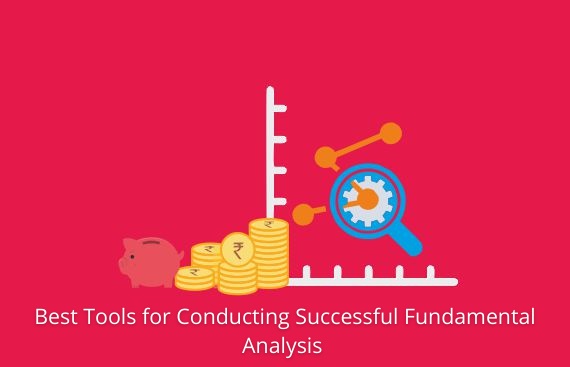Best Tools for Conducting Successful Fundamental Analysis

Whenever we buy or sell a share, we wonder whether we have made the right choice or not. We often follow experts’ advice or a recommendation from a friend. Not all advice is good and not all decisions give us profit.
Instead of depending on other people’s recommendations, learning to do a quick analysis ourselves can prove to be very beneficial, especially in the long run. When we talk of analysing the stock market, we essentially talk about two kinds of analysis – fundamental analysis and technical analysis.
The objective of technical analysis is to predict the future movement of the market or stock by looking into past price movements. It involves analysing charts, which may not be everybody’s cup of tea.
Fundamental analysis, on the other hand, is much simpler. It looks into the basic financials of a company to understand the overall health of the company. Anybody with some elementary knowledge of finance can conduct financial analysis to decide whether a stock is right for their portfolio or not.
Let us understand some key concepts of fundamental analysis and how you can build up your knowledge and empower yourself.
Objectives of Fundamental Analysis Trading
As we mentioned earlier, the main aim of conducting this analysis is to understand the overall health of a company. The objective is to derive the intrinsic value of the company in order to understand whether the current price of the share is lower than its market value or higher. It takes into account all qualitative, quantitative, financial, non-financial, macro and micro-economic factors to arrive at the fair value of a company.
Thus, the main objective is to:
- Understand asset valuation and predict the direction of the share price movement.
- To make projections about the business performance in the coming years.
- Evaluate management style and management’s capability of making financial decisions.
- Identify the competitive landscape
- Know about the industry the company works in.
- And more!
It is a common notion that fundamental analysis can be done for a company only. While it is more often conducted for a company, it is also possible to do a fundamental analysis of the stock market to understand where the market may move in the future.
5 Best Tools for Fundamental Analysis Trading
The financial report of a company is one of the most important documents one looks into while conducting fundamental analysis. There are a host of things that you can understand from the financial report.
Here are 5 of the most important aspects that can help you understand the health of a company:
1. Earning Per Share (EPS)
Earning per share or EPS tells us how much profit one share is entitled to receive. The calculation is simple:
|
EPS = Net income of the company/total number of stocks
|
|---|
It shows the financial progress of a company.
- A higher EPS means the profitability of the company is stronger.
2. Price to Earning Ratio (P/E Ratio)
This is the second most important fundamental analysis ratio. As the name suggests, it shows the relationship between a company’s share price and its earning.
|
P/E = Price/Earning
|
|---|
- A lower P/E ratio shows that the income of the company is higher than what is reflected in the price. Hence, buying the stock may be a good idea. On the other hand, a higher P/E ratio means that the stock is already trading at a price higher than its earning and buying it may not be a good choice. An average P/E ratio means that the share price has the potential to go higher in the future.
However, please note, that the P/E ratio alone is not an indicator of whether a stock is good to invest in. One should consider other fundamental factors before making a buying or selling decision.
3. Price to Book Ratio (P/B Ratio)
This ratio tells us how much equity investors are paying for ?1 of the net asset. It is usually shown in the balance sheet under the head “shareholders’ equity”.
|
P/B Ratio = Stock price/book value per share
|
|---|
Where, book value = owner’s equity
This ratio helps us understand how much the company will be left with if it liquidates all its assets and repays its liabilities.
4. Dividend Yield Ratio
A dividend is a return we all expect when we invest in shares. Sometimes people buy certain shares because they pay good dividends. Naturally, the dividend is an important factor while conducting fundamental analysis.
Dividend yield shows how much a company is paying out in dividends in a year compared to its share price. The ratio is shown as a percentage. It is an important ratio because it tells us how much we are getting back for each rupee invested.
|
Dividend yield ratio = Annual dividend of a share/current share price.
|
|---|
It is common to think that companies with higher dividend yield ratios are the ones to invest in. However, it is important to remember that not all companies pay dividends. Some reinvest their profit to fuel their growth and hence do not pay out dividends. Hence, the dividend yield ratio should not be used as a single indicator of the health of a company.
5. Return on Equity (ROE)
Another important ratio, ROE signifies how efficiently the company is generating a return to its shareholder investment. In other words, it is a measure of how much profit the company is generating by investing shareholders’ money. It is expressed as a percentage.
|
ROE = (net income/book value) X 100
|
|---|
- Generally speaking, an ROE of 13-15 is considered healthy for a company.
ROE is especially useful while comparing several companies of the same industry.
Learning more about fundamental analysis
What we discussed above is only a small glimpse of the vast world of fundamental analysis. There are many more aspects to know about.
If you are looking to enhance your knowledge about fundamental analysis and the financial market in general, Elearnmarkets by StockEdge is a great place to start. They have a range of options suitable for every kind of trader and investor. Many of these courses are offered in association with the National Stock Exchange Academy (NSE).
Apart from innumerable articles and blogs which can be accessed by all, they have separate sections for beginners, traders and investors. All three sections offer self-paced short courses on financial markets, fundamental and technical analysis. They also offer certification courses if you want to carve out a career in the financial markets.
Apart from courses, we also offer free learning which can be accessed at ELM School. There are plenty of modules on financial markets, basic finance, stock investing and many more.
Additionally, traders can take advantage of a paid mentorship program where a market expert hand holds a trader for achieving success in trading.
Similarly, investors have the option to collaborate with like-minded people to share ideas.
Apart from this, they also organize regular webinars where market experts share their opinion about various topics. They also have candid interviews with analysts and traders where you can learn from their experience of the market.
Learning is a very essential step of any trader or investor’s journey. It is worth spending time in learning and enhancing your knowledge to make informed decisions about your portfolio.
Read More News :

